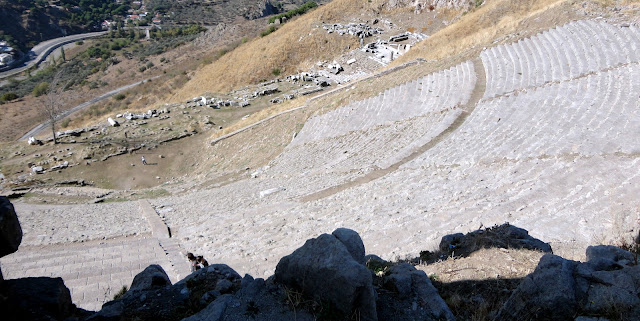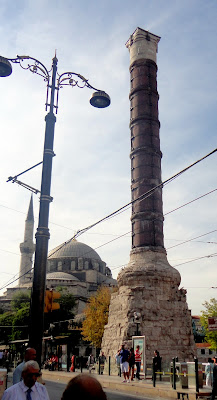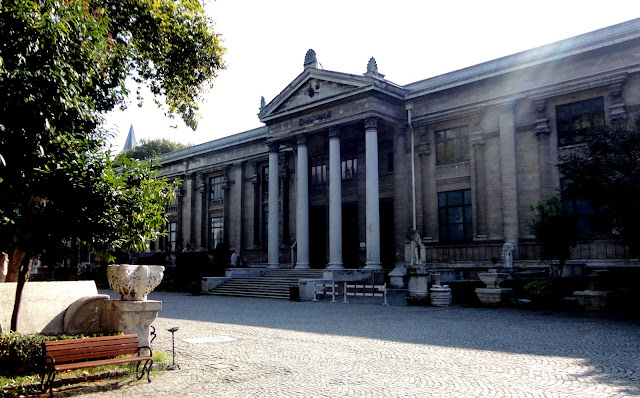After several weeks without travelling (c'mon I'm an Erasmus, I have to explore!) my trip to Ankara finally happened. Since I had a fried studying Dentistry there who offered housing, I didn't think twice!
Seeing the prices, the bus ride was about 100 TL and the plane travel 120 TL by Pegasus airlines. Since the flight takes only 1 hour and the bus ride lasts roughly 8:30 hours I didn't think twice and booked the flight for the 17th November. My trip would last from Friday to Monday.
The first step was getting into the airport (when I arrived in Izmir in September I had someone to pick me up, this time I caught the Metro until Halkapınar an then the slow Izban until the airport).
The flight went smoothly except for the landing - I had a condition named Aerosinusitis which gave me lots of headaches during the all weekend, but that wasn't properly the airline's fault! Once I landed in Ankara Esenboğa Airport (an interesting airport since it even has an interior lake) I had to take the 442 bus. Ankara transport system isn't one of the best - the metro lines don't reach the airport, not even near. I had to go to the Ankara Transport System website (in Turkish of course, without an English option) and with a little help from Google Translator I somehow figured out were that bus stops. After a 40 min journey, and with the assistance of my phone's GPS, I found out the correct stop (yes, the bus doesn't tell you the name of the stations). After a 15 minute walk from Gazi Hospital until the Beşevler station, I was greeted by my friends who took me to their house - they live with 2 Syrian guys and a female Husky puppy!
The first thing I noticed in Ankara was the weather: cold and dry. Izmir in this time of the year has a temperature around 15ºC-20ºC and it was only 6ºC in Ankara. Being clever as I am, I didn't bring gloves or a bonnet, which lead to frozen, swollen and purple fingers and cold ears. Therefore, my whole description of Ankara is influenced by my bad mood and discomfort!
Everyone told me that there was nothing worth seeing in the capital, but I always want to see things by myself to check if it was true or not. For my three-day stay I made a list of the must-see points:
The Mausoleum of Mustafa Kemal Atatürk - Anıtkabir
 |
| Anıtkabir as seen from the sidewalk |
The girls' house was very near to this monument, so we simply walked there. For the ones who have to travel by metro, the exit station is Beşevler ankaray station.
The construction of Anıtkabir, which took nine years, commenced on 9 October 1944 with the ceremony of laying the foundation stone. All stones and marbles used o the construction were brought in from various parts of Turkey, to be a representation of the Turkish People's devotion to Mustafa Kemal.
 |
| The main building who holds Atatürk's symbolic grave |
This is the resting place of Atatürk's body. Having heard so much about Atatürk this past couple of months and seeing how much the Turkish people love him, I felt really honored being able to be there. The place is surrounded by a beautiful park named "Peace Park" (in honor of Atatürk's famous expression "Peace at home, peace in the world"). The place is huge, having a big open square and a main building.
There is also the Museum, depicting many parts of the modern-Turkey history, almost entirely dedicated to Atatürk. It's really informative if you pay attention, and you can now a bit more about why this man is so adored. You can even learn about the story of Atatürk's funeral, how his body didn't decay and was stuffed. Since the tomb in the main building is symbolic (a.k.a. it's empty) there is a live broadcast of Atatürk's real tomb shown (in a non-accessible part of the museum) on a tv screen! Yes, a live broadcast to a tomb! One of the best parts was the gift shop, were I bought a giant Atatürk 2013 Calender, an Atatürk tie and Atatürk car stickers! I have a bit of Atatürk fever right now.
Gençlik Park
 |
| Gençlik Park by night |
Later that day we went to Gençlik Parkı, a very beautiful city park (with a Luna park inside it!). This place is specially great in the night because of all the lights it has. During the day time you can appreciate a water-show in the park's immense fountain. It's also an ideal place to lose things - I actually lost my camera there. Luckily my friend found it untouched, laying in a bush half an hour later. Uffs!
 |
| The main entrance |
Down the hill at the right, hidden in a square, there's the Column of Julian the Apostate, surrounded by administrative buildings. It is popularly known as Belkis Minaresi, or Queen of Sheba and possesses columns derived from Corinthian order. No plaques, no information - if you don't search in advance you won't really know what and old and big column is doing int he middle of a square. It's nothing special if you compare to the ones there are on Istanbul but I thought it was perfect - placed on the edge of a small garden with a fountain in a quiet place, with a stork's nest on the top.
Our next stop was Kocatepe Mosque. It's about some 3 km if you walk from the Gençlik park. You'll walk in some nice streets with several shops and the typical rush-rush of the big cities. When we arrived there, we thought the entrance was at the street level - and we ended up in a shopping center. A complete mall right underneath the mosque, that's modern (and warm, a nice change from the freezing weather outside)! Once we got off, we found the main entrance of the mosque. Let me tell you, I was completely flabbergasted by this mosque. It's very recent, about 25 years old, but it's grandiosity makes it one of the must-see points of Ankara. Inside, I found an amazing lamp right on the center of the mosque, which is beautifully decorated with Arabic motifs and with a wide open space. I can't exactly tell you what amazed me the most, if the decoration of the grandiosity, but I really really liked this place, I could feel peace inside it - I even made a little prayer =)
 |
| The Column of Julian and the small park |
Kocatepe Mosque
 |
| The huge lamp on the center |
Towards the end of the day we went to a fancy street with lots of posh and expensive shops to have a snack before dinner. I didn't want my wallet to be empty so my I decided my stomach should take one for the team.
We did all of those places by walking - undoubtedly the best thing to do if you are sightseeing - but beware that Ankara has lots of hills and few information for tourists. I had the appropriate trainers and my phone's GPS, otherwise I'd be completely lost.
Museums
 |
| Naked fat ladies were famous in ancient times |
We saw we were near the citadel, Ankara's Castle, so we decided to go a bit further up the hill to enter it. When we reached the top, we saw lots of trucks and constructors. Doubting that was the castle, I approached the rock walls and I saw an inscription (in English, the same text that is on Wikipedia!) and yes, that was the castle. I entered the walls and inside there were some nice restaurants and old houses - but all of those closed due to the works they have there. The floor was dirty, holes opened, mud, water everywhere and lots of noise. We decided it was not worth it and we left.
 |
| The Ethnographic museum |
 |
| Entrance to the museum... who was closed |
Our stay came to and end and we had to go the airport. We chose to go on the same bus that drove us from the airport to the city center the previous time, the 442. We checked the internet to see if the bus stop was the same, and on the website it said we could catch the bus on the other side of the road, which makes sense since the bus is driving to the opposite side now. We waited for more than an hour and the bus never came. Time was ticking and our flight was about to departure in a hour. On the exact moment when I was thinking about hitchhiking to the airport (which is not very likely since we were two guys) or taking an expensive cab, my mate had the cleverness of asking a police that was passing by if the bus even stopped here. Turns out we had to take the bus on the same spot it stopped coming from the airport, then I does a complicated circuit on the city center and goes to the airport on another road. We were lucky enough to have a 442 bus the exact moment we crossed the road to the other side. When we realized the bus was still going to the city center on rush hour and our flight was less than one hour away, we started to panic a bit. That's when we realized the time on the ticket was when the gates opened, the actual flight departed half an hour after that. So, thanks to this little mistake we had a really nice scare but we were there in time.
To sum up, I liked Ankara but just for a few days - the city isn't properly beautiful and attractive for tourism, it's not even ready for serious tourism I guess, the metro system is short (it should at least reach a place close to the airport) and the payment should be done in a different method since you pay every time you walk away from the station and enter again, even if it is a 3 minute stop to get the newspaper. The traffic is chaotic, the weather is terrible and cold (compared to Izmir at least) but it has several nice thinks also: it's a green city with lots of parks to walk around, they have some really quiet places to live within the city center (it's really good in my opinion, you live in the city but without all the rush) and there are lots of museums to see (but closed on Mondays!). It's a nice place to visit, but just if you are near it or if you like Turkey's history and Atatürk like me. And hey, after all it's always cool to visit the capital!
















































